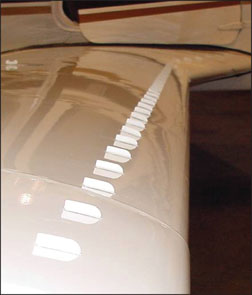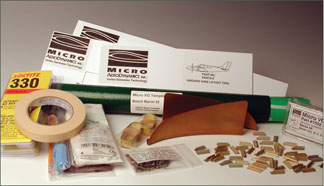
by Rick Durden
For any owner locked into the never-ending quest to make an airplane go faster, stall slower, handle better and maybe hum patriotic songs, there’s no shortage of ads for performance enhancing modifications. Churning through the chaff seeking a kernel of value, we see fairly amazing claims for vortex generators-or VGs as the more hip are inclined to say. On ramps everywhere, we see airplanes with little angular bits of metal protruding from wing surfaces, the underside of horizontal stabilizers and vertical fins, like some weird form of aeronautical acne. We recently set out to find out if VGs really do deliver as the manufacturers claim. We flew a VG-equipped Cessna 310 and surveyed about 80 owners who have installed these mods.
Our findings: They generally deliver on their claims, sometimes dramatically. Owners can expect lower stall speeds and much better slow speed handling, plus reduced liftoff and approach speeds for singles and twins. The downside may be a cruise speed loss of a knot in slower airplanes and up to 3 knots in twins, although not all owners say they see slower cruise with VGs.
The History
Vortex generators appeared nearly 50 years ago, initially to channel localized areas of disturbed airflow over wings that lead to loss of control response. On the Boeing 707, in some flight regimes, the pilot could rotate the yoke 45 degrees with no roll response because airflow over the wing had separated, trapping the ailerons in disturbed air. Solution: Strategically placed metal dams at slight angles to the airflow forward of the mid-chord position generated what are best described as horizontal tornadoes. These caused airflow to adhere to the wing, preventing boundary layer separation. (See the sidebar for more details.)
One might then say that VGs are engineering excuses for poor wing design-something tacked on to correct compromised design. In part, this is correct.Wing profiles for light GA aircraft were designed before computers could crunch the billions of bits needed to optimize an airfoil. The wings we fly are merely good, not perfect.
VGs, then, have become the add-on of choice to optimize the wing for the low-speed end of the envelope and to make the vertical stabilizer and rudder more effective, thus reducing Vmc. VGs have found their way into the light aircraft market through the efforts of a handful of companies.
The actual components of a VG kit vary by the type of airplane for which its intended. Because of the expensive flight test requirements for obtaining STCs for VGs, not every airplane has a kit available. Manufacturers have understandably picked aircraft models whose potential market size justifies the expense of testing the VGs.
Further, in order to get the desired results, the kits cant be a one-size-fits-all for every type of airplane. While the majority of kit components consist of small angled metal channels were used to seeing, some include strakes and other exotic devices. Some kits have gently curved triangles placed on the wing to create a larger vortex that acts as a stall fence to slow the propagation of the stall outward along the wing.
Because VGs protrude through only about 80 percent of the boundary layer, they don’t appear to be affected by inflight icing. Further, theyre usually installed far enough aft so that rime ice doesnt build on them, either.Clear ice, with its propensity to run back, may get into the VGs, but weve heard no reports from owners complaining about icing-related problems with VGs.
Major Players
For light GA, the development of the VG industry has enough plot and character twists to satisfy any soap opera lover. In recent years, however, the market has shaken out to two major players and two lesser players. The company with the greatest number of STCs for VGs is MicroAerodynamics, followed closely by Boundary Layer Research.
RAM Aircraft, the folks who do the popular big-engine mods for twin Cessnas, has some VG STCs and Beech Bonanza specialist Beryl DShannon has kits aimed chiefly at those aircraft.
While BLR doesnt post prices on its Website and is in the process of revamping both the site and prices, feedback from readers and calls to BLR indicate that where BLR and MicroAerodynamics have VGs for the same type of airplane, pricing is competitive, as are performance claims. Kits for most singles are under $1500, with those for the smallest, two-place airplanes as low as $700. Prices for twins start at around $1600 and range to just under $3000. Prices vary depending on whether there’s a takeoff gross weight increase.

Because takeoff weight certification has to do with stall speed, decreasing stall speed may allow an increase in that weight with the installation of VGs. Usually, landing weight increases require more rigorous testing of the landing gear and structure, so only a few VG STCs increase allowable landing weight.
The VG kit contains everything you need to install it, except a ladder, according to one owner comment. Readers enthused about the quality of the kits, clarity of the instructions and ease of installation for both major companies. Many owners we corresponded with said they were able to install the kits themselves, under the supervision of a mechanic, minimizing the cost.
Peel-and-stick templates are laid on defined locations on the airframe. The skin is roughed up at the appropriate locations and each VG is glued in place with the adhesive provided. Strakes, if involved, are bolted or riveted into position. On most airplanes, the face of the airspeed indicator must be replaced because of the changes in stall speed and Vmc.
The manufacturers of VGs locate them slightly differently, with BLR VGs further aft than Micros. We found no evidence that this subtle difference had any effect on the resulting performance. We suspect that there are those who feel passionately about such positioning issues and that there are dark little bars where the argument rages over glasses of beer. Readers reported time to install the kits ranged from a low of three hours for singles to about 12 hours for sophisticated twins.
What to Expect
The initial marketing of VGs was to the owners of multi-engine airplanes. VGs promise to reduce Vmc, thus making the airplanes handling more forgiving and making it more likely that a pilot not up on his skills will keep the airplane upright.
Nonetheless, we still think its imperative that pilots train frequently for engine-out situations. VGs simply arent a substitute for proficiency.
To be sure, VGs do reduce Vmc anywhere from 5 to 12 knots. We sampled the performance of an Aztec D and a Cessna 310R with MicroAerodynamics VGs installed. At gross weight, our tests closely matched the performance claimed by Micro. For the Aztec, Vmc was down from 68 knots to 61 knots and was still above the clean stall speed.
In the 310R, clean stall speed had dropped to 76 knots, Vso was 68 knots. The reduced Vmc published by Micro is 71 knots, we’ll below the clean stall speed. We chose not to perform a single-engine stall in the 310R as part of our Vmc trial, but stopped it when we were we’ll into the stall buffet at about 77 knots, finding the airplane still easily controllable in yaw.
Our view is that it doesnt matter whether a hamfisted pilot coping with an engine out loses control because of the stall or a Vmc roll. Because of the installation of VGs on the wing and the vertical stabilizer, aileron and rudder effectiveness is noticeably improved at low speeds and in the stall.
The airplanes no longer handle as they did when they left the factory.Controls are more effective, not only reducing Vmc, but giving better roll control at and in the stall, reducing the likelihood that a pilot will lose control of the airplane.
Following engine failure, if a pilot flies the airplane at the single-engine best-rate-of-climb speed, VGs mean that the airplane is operating further away from its Vmc, thus the pilot has more room for error in handling the engine out. Another benefit of VGs is that takeoff roll is reduced because the liftoff speed, usually a given speed above Vmc, drops due to the lowered Vmc. Beca use of this, the accelerate-stop distance is reduced, too.This means that more runways can be used safely by a given twin and it increases the margin of safety for any twin on any runway, if the airplane is flown as the STC requires.
Finally, depending on the kit, the installation of VGs may allow an increase in max takeoff weight, ramp weight and zero-fuel weight or some combination of these. For airplanes such as the Cessna 340A, with a tiny useful load when its numerous fuel tanks are filled, a VG-provided gross weight increase makes them nearly standard equipment on these models. But caution is indicated: If you take advantage of the increased takeoff weight, youve got to burn off enough fuel to be at or below max landing weight before you return to earth.
In single-engine airplanes, the advantages of VGs are primarily reduced stall speeds, with a side benefit of noticeably improved control response at low speed. VGs improve aileron response near and at the stall, making it less likely that a pilot who inadvertently stalls a VG-equipped airplane will lose control.
Our flights and reader feedback indicate that the stall of a VG-equipped airplane tends to be more docile than it was pre-VG. Where stall behavior was already good, say in the Cessna 206, VGs didnt negatively affect it.However, there’s no magic bullet. Once the airplane is stalled, no matter how docile it may be, its going to descend and the pilot must act accordingly.

For singles, and to a lesser extent, for twins, VGs function as inexpensive and lightweight STOL kits. This is a big deal for bush operators flying Super Cubs and Huskies which, with tweaked engines, can break ground in under 100 feet in still air. Further, they can safely fly approaches slower than a non-VG-equipped airplane can, and this can radically shorten landing rolls.
Stall handling behavior is also likely to improve with VGs. For airplanes such as the Cub and Champ, with no camber on the tail surfaces, an uncoordinated stall leads to a rapid yaw, roll and pitch down, often resulting in ground impact at low altitude. This phenomenon has come to be known as a moose stall in Alaska, a unique mishap that plagues pilots doing game spotting at low altitude. Owners tell us VGs change this behavior from a sharp break to a more gentle bobbing, giving the pilot time to recover before impact.
Conclusion
While it may be true that VGs are engineering crutches that correct compromised wing design, after flying VG-equipped airplanes and interviewing owners, we believe they work as claimed. We found no evidence that the manufacturers are exaggerating performance claims, although performance is likely to vary case by case.
For twins, VGs are an inexpensive way to improve low-speed handling, control and to reduce Vmc, thus increasing the level of safety. Period. We think theyre among the top safety items any twin owner should have. For singles, VGs seem to give most of the benefits of a STOL kit, without the added weight, with improved low-speed handling, more docile stalls and increased control effectiveness that pays off in crosswinds. Maybe you need those benefits, maybe you don’t.
But maneuvering and landing accidents account for the largest proportion of general aviation accidents and any modification that lowers stall speed and improves low-speed handling is an unqualified safety enhancer, in our estimation. For that reason, as a safety mod, we would put VGs right up there with shoulder harnesses for all of the seats.
Also With This Article
“Checklist”
“How VGs Shape Airflow”
“Owner Survey: Few Complaints”
-Rick Durden is an Aviation Consumer contributing editor.


